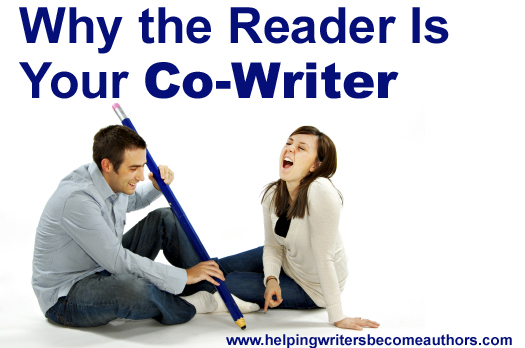No story is created by one person. Written by one person, yes. But if the only imagination involved is the writer’s, the story will never be anything more than black marks on the page. A book is just a doorstop until readers lift the cover, recognize and process the words, and then use those words to bring the story to life in their own minds. When readers decide to join hands with us, they are, in essence, becoming our co-writers.
The Responsibilities of the Reader
This whole collaboration is pretty awesome on a number of levels. For one thing, it means the burden of crafting a perfect story isn’t ours alone. Our job is to guide the readers’ imaginations, but it’s their job to put their imaginations to work in the first place. The story their minds project will never be exactly the one we (not to mention their fellow readers) see.
Admittedly, this can actually get a bit frustrating for the average control-freak writer who doesn’t want readers messing with even the smallest detail of his story. But the good part is that once a reader invests in a story by recreating it in his own imagination, he owns that story just as much as we do. He’s caught in its web just as we are. After that’s happened, chances are good he’s going to love it just as much as we do.
The second awesome thing is that when readers join us as co-writers, the whole concept of suspension of disbelief becomes almost moot. As Steve Almond says:
“All readers come to fiction as willing accomplices to your lies.”
In Creating Characters, Dwight V. Swain agrees:
“…readers know a story isn’t real, isn’t true. But in their role of fiction fans, on an unconscious level they pretend it is true, accept it and live through it with the characters.”
The Responsibilities of the Writer
Other than being kind of a neat concept, what does this notion that the reader is our co-writer mean to us?
To begin with, it means we have to be willing to relinquish just a little bit of control. We have to be able to trust our readers to be smart, to be honest, to be demanding, and to be forgiving. When we come right down to it, we have the most awesome business partners in the world. How many high-powered business gurus would kill to have partners so trustworthy and accomplished? In a Writer’s Digest interview with Jessica Strawser, novelist Chris Cleave expounded:
[T]rust your readers, from the sentence level—you don’t need to hammer a point home—all the way through to the level of the whole novel. You can trust readers to let you write about difficult, complicated subjects…. [Readers] do half the creative work with the novel.
But this hardly means we can dump all the work onto our readers. If we don’t do our job right to begin with, they won’t even have a chance to do theirs. Dwight V. Swain again (this time from Techniques of the Selling Writer):
“That incredible, pompous, egocentric gem from the pen of a “literary” novelist, “I write. Let the reader to learn to read,” would be funny, were it not so ridiculous as to be tragic. To refuse to write so that a mass audience can understand you, and then rage because that same audience rejects you, is about on a par with insisting that grade-school youngsters learn their ABC’s from college physics texts. Most professionals accept it as their job to devise ways to communicate with their readers, regardless of said readers’ level. After all, if you feel too superior, you can always go hunt a different market.”
The Bottom Line
Authors don’t always know quite how to relate to readers—which is ironic, since not only are readers pretty easy to figure out, they’re also a club to which almost all authors belong themselves.
To understand the balance of power between author and reader, all we have to do is consider our own reading experiences. What authors have given you the greatest amount of creative control (and, as a result, emotional investment) in their stories? Which authors have hoarded the co-writing responsibilities and prevented you from adding your own imaginative flourishes? And which authors have demanded too much production from you without supplying the tools your imagination needs to work with?
The reader isn’t an enemy or a dupe. He wants to love your story. He wants you to sweep him off his feet into a world of excitement and insight. He can’t wait to be your partner, and the only way you can endanger all that enthusiasm is by either failing to fulfill your own responsibilities—or by failing to trust him with his. Paul Auster says it like this:
“…the book doesn’t only belong to the writer, it belongs to the reader as well, and then together you make it what it is.”
Photo Credit
Photo courtesy of K.M. Weiland
Originally posted on Wordplay: Helping Writers Become Authors



Please Share Your Thoughts - Leave A Comment!